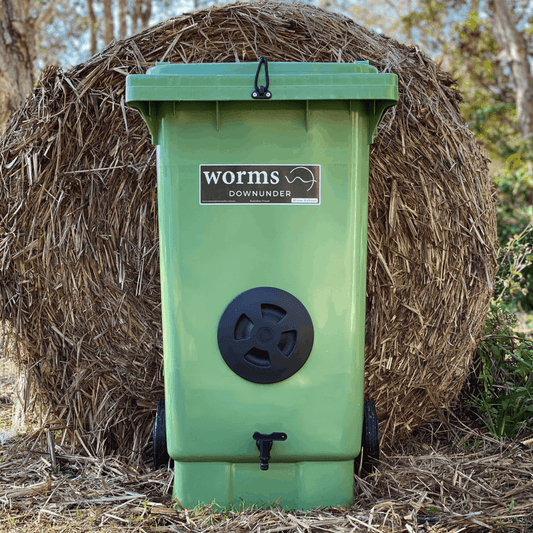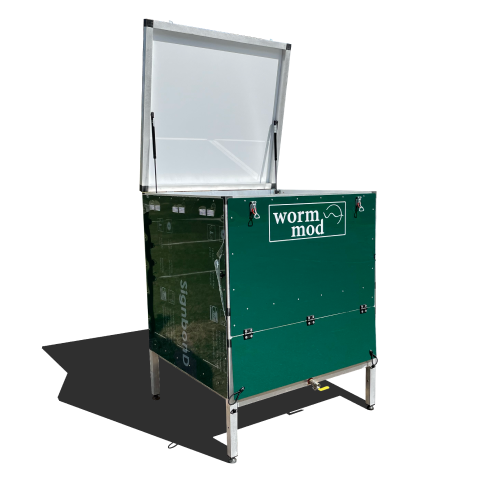Facts about composting worms
Fact #1– worms are cold-blooded
Being cold-blooded means worms don’t have the ability to regulate their body temperature. This is why managing temperatures in your worm farm is important. Aim for your worm bedding temperature (as opposed to air temperature) to be around 16 – 27°C, give or take. Your worms will tolerate ranges of 4 – 32°C, however, they may become less productive at the temperature extremes.
Fact #2 – worms breathe through their skin
That’s right, your hard-working worm friends have no lungs! They ‘breathe’ through their skin. This is why it’s important your worm farm is kept damp as they require moist skin to allow dissolved oxygen to pass through into their bloodstream. If the bedding becomes too dry, worms must exude body fluids to moisten their skin. This process will weaken your worms causing them to eat and reproduce more slowly. Ultimately, they will die if the environment is not corrected.
Fact #3 – worms are hermaphroditic (yet takes two to tango)
Which is likely why worms are such excellent breeders! A mature worm (53 – 76 days old) can produce 2-3 golden brown, shiny cocoons per week (they look like teeny lemons the size of a match head). On average 3 or 4 babies will hatch from each cocoon, resembling whitish pieces of thread less than 6mm long. Your worms will reproduce quickly when food and water are available, doubling in population roughly every 3 months. When conditions are not favourable, cocoons will stay dormant and not hatch for months to years! This is why worms have survived for 500 million+ years.
Fact #4 – composting worms are hungry hard workers
Worms will eat anywhere between half their body weight right up to their body weight of organic matter per day. On average they will consume 50% of their body weight per day. That’s what makes them such awesome super-composters!

Tips for managing composting worms
Tip #1 – don’t overfeed your worms
Over feeding is one of the most common mistakes people make when starting out. Too much waste (relative to quantity of worms) can cause the food to sit unprocessed and start to rot then become smelly and acidic. So, ensure you wait until at least half of your last feedstock has been consumed before adding more food. As noted above, worms will process on average around 50% of their body weight a day. So, do the math and work out how many worms you require for your specific needs. If starting with a small number of worms, say 1,000 (250g) – 2,000 (500g), then on average you would process only 125-250g of material per day. Don’t worry though if your budget doesn’t stretch to buying a couple of kilos of worms to start with. If you look after your worm-workers, they will double every 3 months and you will have tens of thousands before you know it!
Tip #2 – carbon, carbon, carbon
Not enough carbon is another one of the main mistakes people make early on. Most people put in their leftover food waste (usually high in nitrogen) and forget about carbon inputs (such as shredded paper, cardboard, brown leaves, sugar cane mulch). Keeping up the carbon is the key to maintaining a healthy habitat. The ideal carbon (‘browns’) to nitrogen (‘greens’) ratio for vermicomposting is approximately 50:1. To achieve this (without getting all scientific and complicated), as a general rule aim to feed your worms roughly 50% ‘green stuff’ and 50% ‘brown-stuff’. Not only do your worms love it but it’s a great sustainable way to manage this extra waste.
Tip #3 – add dolomite to your worm farm
The pH of organic materials indicates whether it is acidic (1 to 6), neutral (7), or alkaline (8 to 14).
Worms can grow in bedding with a pH range between 5 and 8. However, they will absolutely thrive if pH is 6.5 – 7. As the most common issue is with over-feeding resulting in acidity, many people add a very light sprinkling of dolomite every couple of weeks to keep things in balance.
Tip #4 – cut, shred, mulch, blend, freeze worm food
Increasing the surface area of your organic matter will greatly improve the efficiency of your worm farm as it provides more area for the worms and microorganisms to work on. So reducing the particle size of your inputs as much as possible will help ensure your worm farm is churning through waste as efficiently as possible. P.S. worms love smoothies! P.P.S If you freeze green scraps (great if in a hurry), it causes the plant cell walls to rupture and they thaw out soft and soggy – just the way worms like it!
Tip #5 – managing temperatures
Managing hot temperatures through our scorching Australian summers can be challenging, but here are some tips to help ensure your worms survive and even thrive through the hotter months.
- Having a worm farm with a large thermal mass (rather than thin layers of tray designs for example) is one of the best mitigations for temperature fluctuations (hot or cold). The temperatures in the core of the large bedding mass, remain more constant and less impacted by external air temperatures. If too hot or cold towards the surface or edges, the worms have somewhere to escape to. They may seek refuge during the day and surface at night when cooler to eat. A thin layer of bedding in a tray style worm farm is far more susceptible to extremes of temperature which is why all of our habitat designs embody the large thermal mass principle.
- Add thinner layers of feed to minimise the heat generated by decomposing food (only 2.5cm thick)
- Limit feed to certain sections of the bin so that there are cooler areas where the worms can go to escape decomposing, heat-conveying food.
- Your instinct may be to cool down the bin by spraying lots of water. However, this may actually cause the bin to heat up as water fills the (crucial) air pockets in the bedding, bringing about anaerobic conditions.
- Instead of spraying water to soak the bedding, always use a fine mist.
- Freezing your scraps prior to feeding can also assist in dropping temperature levels.
- Always ensure your habitat is located in a fully shaded area throughout summer.
Tip #6 – checking your moisture levels – the ‘squeeze test’
Keeping your worms moist and cool is key to maintaining a healthy worm farm environment, particularly through the hot summer months. Your worm farm environment should maintain a moisture content range of 70 – 80%. How do you know if your worm farm is the correct moisture level? Visually inspect the bed to see if it looks moist and the worms have glistening skin. Just by looking, you will be able to see if the bedding or the worms have begun to dry out. Then do the ‘Squeeze Test’ by grabbing a handful of bedding (remove your worm friends) and squeezing it in your hand. If lots of water drips out, it is too wet. If when you open your hand, the material crumbles, it is too dry. If you only got 1-2 drops of water upon squeezing, the moisture level is spot on.
INSERT VIDEO LINK
Tip #7 – aerate your bedding
Vermicomposting is an aerobic process (oxygen is present). The worms do most of the hard work for you keeping the environment aerobic as they ‘turn’ the bedding when they burrow and channel their way through the worm farm environment. However, lightly aerating your bedding can assist in ensuring the environment doesn’t become damp and anaerobic (a common outcome of too many scraps) which are conditions your worms do not enjoy. Aerate your habitat with a rounded end garden fork or gloved hands to ensure it’s gentle for your worms. Also frequently adding ‘brown’ inputs with some structure such as mulch or crunchy dead leaves assists in creating air pockets through the bedding. Lightly fold these through the top few inches of your bedding.
Tip #8 – aged manure (horse, cow etc) is great for your worm farm
If you’re experiencing any issues with your worm farm, aged manure from horses or cows is an excellent ‘pick me up’ to assist in resetting conditions to get your habitat back on track. Aged manure is a good carbon:nitrogen ratio (approx 20-30:1) so it’s a good food source for keeping your environment at a good balance. It also improves the structure of the bedding helping to keep it aerobic. Make sure you wet it well first though as it can get a bit dry inside. As long as it is ‘aged’ (at least a week or two) you don’t need to worry about traces of worm medicine – it will be long gone. Adding aged manure with some additional structured carbon such as brown leaves or mulch is the perfect ‘pick me up tonic’ to help resolve the majority of worm farm issues.



